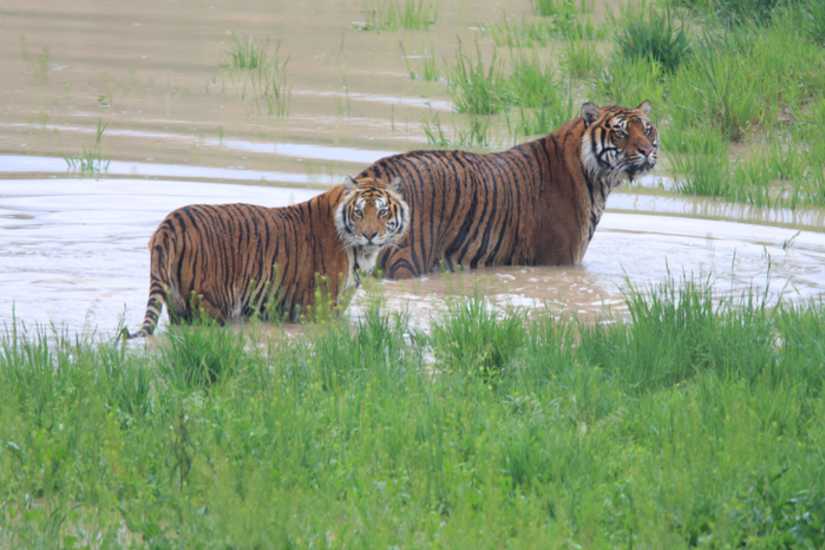Wild Animal Sanctuary – A Haven for Rescued Wildlife and Conservation Efforts
Introduction
Wild animals hold a special place in our hearts, captivating our imaginations and inspiring awe. However, due to various reasons such as habitat loss, poaching, and illegal wildlife trade, many species find themselves in desperate situations. Fortunately, there are places known as wild animal sanctuaries that serve as havens for rescued wildlife, offering them safety, care, and a chance at a better life. In this article, we will explore the world of wild animal sanctuaries, their importance, and their role in conservation efforts.
What is a Wild Animal Sanctuary?
A wild animal sanctuary is a specialized facility that provides shelter, care, and rehabilitation for wild animals in need. These sanctuaries can be large expanses of natural habitat or purpose-built enclosures designed to mimic the animals’ natural environments. The primary goal of a wild animal sanctuary is to provide a safe haven for animals that have been rescued from various situations, such as illegal captivity, abusive conditions, or injuries.
Importance of Wild Animal Sanctuaries
Providing a Safe Haven for Rescued Wildlife
Wild animal sanctuaries play a crucial role in providing a safe and secure environment for rescued wildlife. Many animals in these sanctuaries have suffered traumatic experiences and require extensive care and rehabilitation. Sanctuaries offer them a chance to recover physically and mentally, away from the dangers they faced in the wild or captivity.
Rehabilitation and Release Programs
In addition to providing a safe haven, wild animal sanctuaries often have rehabilitation programs aimed at preparing animals for potential release back into the wild. Skilled caretakers and veterinarians work closely with the animals, providing medical treatment, behavioral enrichment, and training necessary for their successful reintegration into their natural habitats whenever possible.
Conservation and Education
Wild animal sanctuaries also serve as important educational centers, raising awareness about wildlife conservation issues and inspiring visitors to become advocates for the protection of animals and their habitats. Through guided tours, educational programs, and interactive exhibits, these sanctuaries engage the public and promote a deeper understanding of the challenges faced by wild animals.
How are Wild Animal Sanctuaries Different from Zoos?
While both wild animal sanctuaries and zoos aim to care for animals, there are significant differences between the two. Zoos often prioritize entertainment and exhibition, while wild animal sanctuaries focus on the welfare and well-being of the animals. Sanctuaries aim to create environments that closely resemble the animals’ natural habitats, allowing them to exhibit their natural behaviors and live more fulfilling lives.
Unlike zoos, wild animal sanctuaries typically do not engage in breeding programs or commercial activities involving animals. Their primary goal is to provide a haven for rescued animals and, whenever possible, facilitate their return to the wild.
The Role of Wild Animal Sanctuaries in Conservation Efforts
Wild animal sanctuaries contribute to conservation efforts in several ways. Firstly, by rescuing and rehabilitating animals, they directly contribute to the preservation of endangered species and the overall biodiversity of ecosystems. Secondly, sanctuaries serve as centers for scientific research and monitoring, providing valuable data on animal behavior, habitat requirements, and the impact of human activities on wildlife.
Moreover, wild animal sanctuaries collaborate with other conservation organizations, governmental bodies, and local communities to develop strategies for protecting habitats and raising awareness about wildlife conservation. By involving the public and fostering a sense of responsibility, sanctuaries create a network of support that extends beyond their immediate boundaries.
Examples of Successful Wild Animal Sanctuaries
- The Elephant Sanctuary – Located in Tennessee, USA, this sanctuary provides a safe haven for elephants retired from circuses and zoos. It offers expansive natural habitats where elephants can roam freely and receive specialized care.
- The David Sheldrick Wildlife Trust – Based in Kenya, this sanctuary focuses on rescuing and rehabilitating orphaned elephants and rhinos, providing them with round-the-clock care until they are ready to be reintegrated into protected wilderness areas.
- The Borneo Orangutan Survival Foundation – Situated in Indonesia, this sanctuary is dedicated to the rescue and rehabilitation of orangutans displaced by habitat destruction and illegal pet trade. It plays a vital role in safeguarding this critically endangered species.
Challenges Faced by Wild Animal Sanctuaries
Wild animal sanctuaries encounter numerous challenges in their mission to protect and care for rescued wildlife. Financial constraints, limited resources, and the increasing demand for their services often pose significant hurdles. Sanctuaries also face regulatory complexities, as they must adhere to strict guidelines and obtain permits for the rescue, rehabilitation, and release of animals.
Furthermore, the conservation efforts of wild animal sanctuaries are intertwined with broader environmental issues such as habitat loss, climate change, and illegal wildlife trade. Addressing these challenges requires collaboration among various stakeholders, including governments, non-profit organizations, and the public.
How You Can Support Wild Animal Sanctuaries
There are several ways you can support the important work done by wild animal sanctuaries:
- Volunteer or Intern: Many sanctuaries offer volunteer and internship programs, allowing you to contribute your skills and time directly to the care of animals. Check with your local sanctuaries for opportunities.
- Donate: Financial contributions play a vital role in sustaining the operations of wild animal sanctuaries. Consider making a donation to support their efforts and help provide necessary resources for the animals.
- Spread Awareness: Share information about wild animal sanctuaries and the issues they tackle through social media, educational presentations, or organizing awareness events. Engage your friends, family, and community in conversations about wildlife conservation.
- Support Ethical Tourism: When visiting wildlife attractions, choose reputable sanctuaries that prioritize the well-being and conservation of animals. Avoid activities that exploit or harm wildlife.
- Advocate for Policy Change: Stay informed about wildlife conservation policies in your region and actively participate in advocating for stronger laws and regulations that protect animals and their habitats.
Conclusion
Wild animal sanctuaries are invaluable institutions that provide a lifeline for rescued wildlife and contribute significantly to conservation efforts. By offering a safe haven, rehabilitation programs, and educational opportunities, these sanctuaries play a critical role in protecting endangered species and promoting a harmonious relationship between humans and the natural world. By supporting these sanctuaries and their initiatives, we can collectively make a difference in preserving our planet’s precious wildlife.
FAQs
Q1: Can I visit a wild animal sanctuary? A: Many wild animal sanctuaries allow visitors, but it’s important to research and choose ethical sanctuaries that prioritize animal welfare and conservation.
Q2: How do wild animal sanctuaries fund their operations? A: Wild animal sanctuaries rely on a combination of funding sources, including donations from individuals, grants, sponsorships, and revenue from visitor programs.
Q3: Are wild animal sanctuaries only for large animals like elephants and tigers? A: Wild animal sanctuaries rescue and care for a variety of species, including both large and small animals. They cater to the specific needs of each species they rescue.
Q4: Can wild animals in sanctuaries be released back into the wild? A: The release of animals back into the wild depends on several factors, including their health, behavior, and the availability of suitable habitats. Sanctuaries prioritize the well-being and safety of animals when making such decisions.
Q5: How can I verify if a wild animal sanctuary is reputable? A: Look for accreditations or certifications from recognized bodies such as the Global Federation of Animal Sanctuaries (GFAS) or the Association of Zoos and Aquariums (AZA). These certifications ensure that sanctuaries meet specific standards of animal care and welfare.
Read More:Wild Animal Safari – Unveiling the Thrilling Adventure of Exploring Wildlife




















